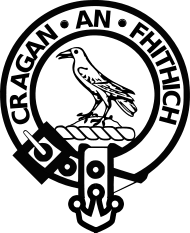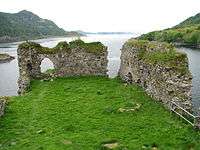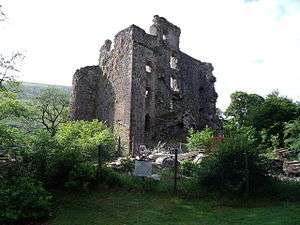Clan MacDonell of Glengarry
Clan MacDonell of Glengarry (Scottish Gaelic: Clann Dòmhnaill Ghlinne Garaidh) is a Scottish clan and is a branch of the larger Clan Donald.[3] The clan takes its name from Glen Garry where the river Garry runs eastwards through Loch Garry to join the Great Glen about 16 miles (25 km) north of Fort William, Highland.
| MacDonell of Glengarry | |||
|---|---|---|---|
| Clann Dòmhnaill Ghlinne Garaidh[1] | |||
 | |||
| Motto | Creag an Fhitich (The Raven's Rock)[2] | ||
| Profile | |||
| Region | Scottish Highlands | ||
| District | Ross | ||
| Plant badge | Heath[2] | ||
| Pipe music | Glengarry Foot Stomp. | ||
| Chief | |||
| Aeneas Ranald Euan MacDonell, 23rd Chief of Chief of Macdonell of Glengarry | |||
| Historic seat | Strome Castle Invergarry Castle | ||
| |||
| |||
History
Origins of the clan
.jpg)
Glengarry is in Lochaber which was part of the ancient Kingdom of Moray that was ruled by the Picts.[3] Ranald was the son of John of Islay, Lord of the Isles, and Ranald himself had five sons.[3] One of them was Alan, the progenitor of the Clan Macdonald of Clanranald and another was Donald.[3] Donald married twice: firstly Laleve, daughter of the chief of Clan MacIver, by whom he had one son named John.[3] Donald married secondly a daughter of the chief of the Clan Fraser of Lovat by whom he had two more sons, Alexander and Angus.[3] The first son, John, died without heirs and was therefore succeeded by his half-brother Alexander.[3] Alexander is sometimes considered the first true chief of Glengarry but is usually regarded as the fourth.[3]
15th and 16th centuries
Glengarry did not play an important part in the politics of Clan Donald until the late fifteenth century.[3] Traditional rights of the chiefs were being replaced with feudal relationships in which the Crown was the ultimate superior, as part of the royal policy to pacify the Scottish Highlands.[3] Most of the chiefs submitted to James V of Scotland and even the Clan Macdonald of Clanranald accepted charters in 1494.[3] However Alexander of Glengarry did not receive a charter, suggesting that he continued to have a rebellious attitude at this time.[3] Finally in 1531 he submitted to royal authority and was pardoned for past offences.[3] He received a Crown charter on 9 March 1539 for the lands of Glengarry, Morar, half the lands of Loch Alsh, Lochcarron, Loch Broom and also Strome Castle.[3] This did not stop Alexander following Donald Gorm Macdonald of Sleat in trying to reclaim the Lordship of the Isles.[3] Donald Gorm was killed attacking Eilean Donan Castle and the rebellion collapsed.[3]

Subsequently Alexander of Glengarry was amongst the island chiefs who were tricked into meeting James V at Portree and was imprisoned at Edinburgh where he remained until the king died in 1542.[3] Glengarry himself died in 1590.[3] His son was Angus who was politically astute and used the influence of his father-in-law, the chief of Clan Grant, to gain a charter from James VI of Scotland, regaining his ancestral estates in 1574.[3]
In a bond of manrent, dated 1571, between Angus MacAlester of Glengarry and Clan Grant, Glengarry makes an exception in favour "of ye auctoritie of our soverane and his Chief of Clanranald only ". This is held by Clanranald of Moydart as an acknowledgment by Glengarry of the Captain of Clanranald as his chief.[4]
17th century

The Battle of Morar was fought in 1602 between the Clan MacDonell of Glengarry and Clan Mackenzie.[5] Angus was succeeded by Donald, 8th chief, who is reputed to have lived for over one hundred years.[3] Invited in 1626 by Lord Ochiltree, the Lord Chancellor of Scotland to discuss Royal policy for the Western Isles, he disagreed with the proposals and was imprisoned for a time.[3] Despite this, in March 1627 he obtained a charter under the great seal that erected Glengarry into a free barony.[3]
When the 1638-1652 Wars of the Three Kingdoms began, Donald was too old for active campaigning and leadership passed to his son, Aeneas, later 9th chief.[3] He served under James Graham, 1st Marquis of Montrose throughout his 1644-1645 campaign and protected him after the Battle of Philiphaugh.[3] Aeneas forfeited his estates when Scotland was incorporated into the 1653 to 1659 Protectorate. They were returned after the 1660 Restoration and he received the title Lord Macdonell and Aros.[3]
When James II & VII was expelled in the 1688 Revolution, the Glengarry MacDonells were among the 2% of Scots who remained Catholics. Ranald acted as head of the Catholic Jacobite faction and during the 1689 Rising, the Scots Parliament confiscated his lands, although he continued to hold Invergarry Castle.[6] By late 1691, Invergarry was closely besieged and the Scottish government was determined to 'make an example' of the Macdonells. However, after agreeing to pardon Ranald, they switched targets to the Glencoe MacDonalds, which resulted in the Glencoe Massacre.[7]
18th century to modern day
_-_Google_Art_Project.jpg)
Glengarry took part in the Jacobite rising of 1715 and fought at the Battle of Sheriffmuir.[3] When the captain of the Clan Macdonald of Clanranald was killed, Glengarry is said to have rallied his men by throwing up his bonnet and crying Revenge today and mourning tomorrow; in 1716, James Francis Edward Stuart made him Lord Macdonell in the Jacobite peerage.[3] General Wade's report on the Highlands in 1724, estimated the clan strength at 800 men.[8]
Glengarry's Regiment served throughout the 1745 Rising, initially led by Aeneas, Glengarry's second son; he was accidentally shot dead after Falkirk and replaced by his kinsman Lochgarry who commanded at the Battle of Culloden. His elder brother Alastair, later 13th Glengarry was captured by a British frigate in November 1745 when travelling from France to join the Rising. Imprisoned in the Tower of London, he was released in 1747 and at some point became a British government double agent.[9] His reasons are still disputed but Scottish historian Andrew Lang confirmed his identity as 'Pickle the Spy' in 1897.[10]
The Highland Clearances of the early 19th century forced the majority of Clan MacDonell of Glengarry into exile; most settled in Glengarry County, Ontario and parts of Nova Scotia.[11] These were driven by the 15th chief, Alexander Ranaldson MacDonell, who was allegedly the model for haughty and flamboyant Highland chieftain Fergus MacIvor in Walter Scott's 1814 novel, Waverley. In June 1815, Glengarry formed the Society of True Highlanders, a rival to the Celtic Society of Edinburgh; he was closely involved in arguments over precedence before, during, and after George IV's visit to Scotland in 1822. The occasion is best remembered for popularising the idea of tartans and Highland dress.
His contemporary Alexander Macdonell (1762-1840) became a Catholic priest in Lochaber. In 1794, during the French Revolutionary Wars, he served as chaplain in the Glengarry Fencibles, which was disbanded in 1804. Father Macdonell accompanied his clansmen to Glengarry County and helped reform the regiment for service in the War of 1812. In 1826, he was appointed first bishop of Kingston, Ontario.
Castles
- Invergarry Castle which is situated on the Raven's Rock was the seat of the Chief of Clan MacDonell of Glengarry.
- Strome Castle was also the previous seat of the MacDonells of Glengarry until 1602.
The current and 23rd Glengarry is Aeneas Ranald Euan MacDonell.[12]
References
- Mac an Tàilleir, Iain. "Ainmean Pearsanta" (docx). Sabhal Mòr Ostaig. Retrieved 15 October 2009.
- Clan MacDonnell of Glengarry Profile scotclans.com. Retrieved 24 November 2013.
- Way, George and Squire, Romily. Collins Scottish Clan & Family Encyclopedia. (Foreword by The Rt Hon. The Earl of Elgin KT, Convenor, The Standing Council of Scottish Chiefs). Published in 1994. Pages 214 – 215.
- Mackenzie (1881), p. 307; p. 308.
- 'Conflicts of the Clans' published in 1764 by the Foulis press, written from a manuscript wrote in the reign of James VI of Scotland.
- Love, Dane (2007). Jacobite Stories. End of Chapter 3: Neil Wilson Publishing. ISBN 1903238862.CS1 maint: location (link)
- Cobbett 1814, p. 904.
- Johnston, Thomas Brumby; Robertson, James Alexander; Dickson, William Kirk (1899). "General Wade's Report". Historical Geography of the Clans of Scotland. Edinburgh and London: W. & A.K. Johnston. p. 26. Retrieved 19 February 2020.
- Davenport-Hines 2019, p. 36.
- Lang 1897.
- Preeble 1963, pp. 60-61.
- MACDONELL OF GLENGARRY, CHIEF OF MACDONELL OF GLENGARRY Retrieved on 18 September 2007
Sources
- Cobbett, William (1814). Cobbett's Complete Collection Of State Trials And Proceedings For High Treason And Other Crimes And Misdemeanors (2011 ed.). Nabu Press. ISBN 1175882445.CS1 maint: ref=harv (link)
- Davenport-Hines, Richard (2019). Enemies Within;. Williams Collins. ISBN 978-0007516698.CS1 maint: ref=harv (link)
- Lang, Andrew (1897). Pickle the spy; or, The incognito of Prince Charles. Longmans Green.CS1 maint: ref=harv (link)
- Preeble, John (1963). The Highland Clearances (1982 ed.). Martin Secker & Warburg Ltd. ISBN 978-0436386046.CS1 maint: ref=harv (link)
- Clans and Tartans – Collins Pocket Reference, George Way of Plean and Romilly Squire, Harper Collins, Glasgow 1995 ISBN 0-00-470810-5
- The King's Jaunt, John Prebble, Birlinn Limited, Edinburgh 2000, ISBN 1-84158-068-6
- Mackenzie, Alexander (1881). History of the Macdonalds and Lords of the Isles; with genealogies of the principal families of the name. Inverness: A. & W. Mackenzie.